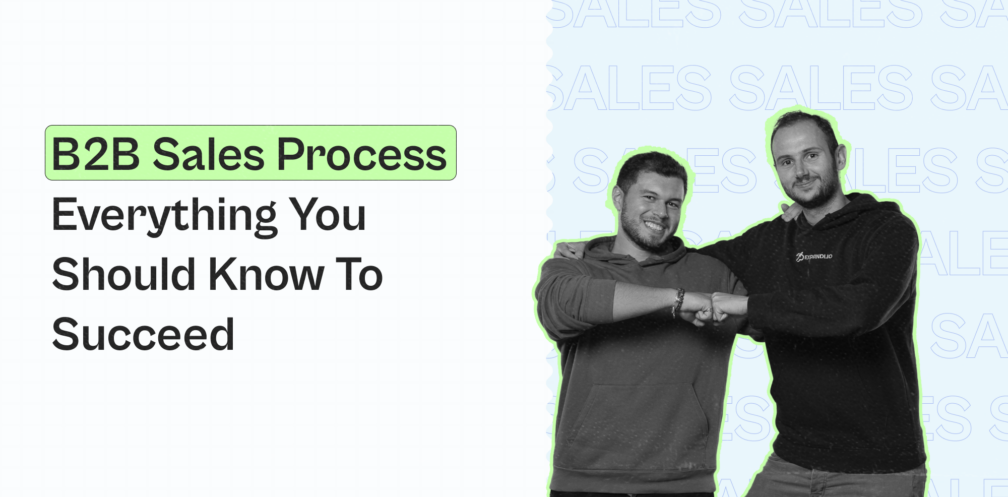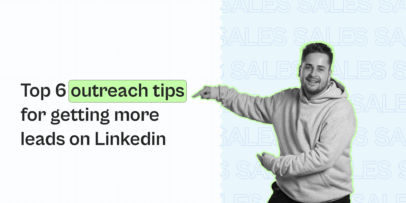B2B Sales Process — Everything You Should Know to Succeed

Are you struggling to boost your B2B sales? Well, with the right understanding of what makes a successful sales process and the tools to help you succeed in advancing your sales strategy, you can achieve great results.
In this article, we will cover everything you need to know about the B2B sales process, from understanding your target audience to building long-term relationships with clients. We will dive deeper into how your sales funnel works, what are the stages of the sales cycle, and how to train your sales team for success.
What are B2B Sales?

First, let’s define what we mean by B2B sales. B2B sales involve selling products or services to other businesses rather than individual consumers. This type of sales process often involves longer sales cycles, more complex decision-making processes, and higher order values.
Overview of the B2B Sales Process
The B2B, sales and marketing process typically involves the following stages:
- Lead generation: B2B lead generation is the process of identifying potential clients who might be interested in your products or services.
- Qualification: once you’ve generated leads, you need to qualify them, i.e. determine if they are a good fit for your offer.
- Needs analysis: a needs analysis is conducted to help you better understand your qualified leads’ specific needs and issues.
- Proposal: based on the needs analysis, you can develop a proposal that outlines how your offer can solve your leads’ problems.
- Closing: this involves negotiating terms, addressing any objections or concerns, and securing a commitment from the lead to move forward with the purchase.
Understanding Your Target Audience

Identifying Your Ideal Customer Profile
The first step in understanding your target audience is identifying your ideal customer profile. Your ICP is a detailed description of the type of customer that would best fit your company’s offer. Factors to consider when developing an ICP include company size, industry, job title, and pain points that your offering can successfully address and solve.
Buyer Persona Development
Developing your buyer persona basically means creating a fictional representation of your ideal customer based on real-world data that you collect through research. Apart from details such as job title, company size, and pain points, it includes specific characteristics, such as purchasing behavior.
Customer Journey Mapping

In order to successfully map the customer journey that your company provides, you need to pinpoint all the different touchpoints that a prospect might have with your brand or offer. This includes visiting your website, signing up for a trial, interacting with your sales influencers and reps, etc.
As you map out the customer journey, pay close attention to any areas where the customer experience could be improved. Think about how confusing your website navigation is, how fast or slow your sales reps’ response times are, or how difficult it may be for customers to access support resources.
Prospecting
Prospecting can be done in two very different ways: outbound and inbound.
Outbound prospecting involves actively reaching out to potential customers or clients through cold calls, emails, or direct mail. This method requires a lot of effort and time to identify and engage with prospects who may not have any prior interest in the product or service being offered.
On the other hand, inbound prospecting involves creating valuable content, optimizing search engine rankings, and leveraging social media to attract potential customers or clients. This method focuses on creating a strong online presence and establishing authority in the industry to attract prospects who are already interested in the product or service.
In this article we concentrate on outbound prospecting approaches.

Outboud prospecting approaches
- Utilize social media platforms. Using the search and filtering functions on platforms like LinkedIn, businesses can easily identify potential customers based on their job titles, industries, and other relevant criteria. Social media also provides a great opportunity to connect with potential clients and establish a relationship with them before making a sales pitch.
- Use targeted marketing campaigns – PPC. Targeted marketing campaigns can be an effective way to reach potential customers and generate leads. They are created through the use of data collected with sales prospecting tools, thanks to which ads are able to reach the right people with appropriate and impactful messaging.
- Cold calling and cold emailing. While these tactics may not be as effective as they once were, cold calling and cold emailing can still be useful strategies for B2B sales prospecting.
- Attend industry events and conferences. Attending relevant events in your industry is a fantastic way to network with potential clients in person. At events like these, business owners can meet decision-makers in their target industries and start laying the foundations for fruitful B2B relationships. You can also scrape attendees from relevant LinkedIn events and start cold outreach to those you’re planning to meet.
Importance of Personalization
Personalizing your sales approach means tailoring your messaging to the specific needs and interests of individual clients. To do this, you need to have a deep understanding of their challenges and goals, and speak directly to those issues in your comms.
Personalization can be as simple as using a customer’s name in an email, referencing their specific industry or job title, or even creating customized content or offers based on their unique needs.
Demonstrating that you understand the client well enough allows you to establish a positive relationship from the very beginning of buying process. This can make it easier to move the sales process forward and ultimately close deals.
Prospecting Automation

Did you know that you can automate a big portion of the prospecting customer buying process?
Expandi is an all-in-one LinkedIn automation tool that enables businesses to streamline their outreach efforts. Whether you are a business owner, recruiter, growth marketer, or startup founder or similar, Expandi can help you generate quality leads and convert them into loyal clients.
- Expandi allows users to scrape LinkedIn profiles and extract data such as job titles, company names, location, and more. Additionally, Expandi’s scraping feature enables users to filter search results based on various parameters such as location, industry, language, and more. The tool also allows users to scrape company pages and extract data such as employee count, industry, and location. With these scraping features, Expandi can help businesses to identify and connect with potential customers and partners on LinkedIn more efficiently.
- With its smart, automated sequences, Expandi enables you to easily contact your prospects via email or LinkedIn. Its automation features eliminate the need for manual follow-ups and help you save time and effort.
- In addition to automation, Expandi also enables you to create personalized touchpoints for your target audience. With its image and GIF personalization feature, you can add a creative touch to your outreach and uplift sales engagement by 2.2x!
Simply put, Expandi is a must-have tool for anyone looking to optimize their outreach process, generate quality leads, the sales funnel, and drive conversions. Sign up for a trial run and see for yourself!
Qualifying Leads

Defining a Qualified Lead
Once you’re done generating new leads, through traditional means or newer ones like ChatGPT, it’s time to appropriately qualify them.
A qualified lead is a potential client who meets specific criteria and has a high likelihood of converting. The process of identifying and defining qualified leads is essential for a successful sales process for any B2B company — it can save time, increase efficiency, and ultimately drive more revenue and agency growth.
So, how do you define a qualified lead?
A qualified lead is a potential customer who has shown a genuine interest in a company’s products or services and is more likely to become a paying customer. To define a qualified lead, businesses use specific criteria to evaluate a lead’s level of interest and engagement with their brand.
- A Marketing Qualified Lead (MQL) is a lead who has engaged with a brand’s marketing efforts and meets certain criteria, indicating a higher likelihood of becoming a customer.
- A Sales Qualified Lead (SQL) is an MQL that has been evaluated by the sales team and determined to be a good fit for the company’s products or services, based on their level of engagement and readiness to make a purchase.
Once an SQL has been identified, the sales team works to turn it into a Sales Accepted Opportunity (SAO) by providing the lead with more personalized attention and guiding them towards a purchase decision. SAOs are leads who have been qualified as potential customers and have expressed a desire to purchase the company’s products or services.
Qualification Criteria
One of the widely used sales qualification methodologies is BANT (stands for Budget, Authority, Need, and Timeline). This method helps sales teams to determine if a prospect is a good fit for their product or service based on their budget, decision-making authority, level of need, and timeline.
Here are the four qualification criteria in the BANT methodology:
- Budget: The first criterion in the BANT methodology is budget. Sales teams need to determine if the prospect has the financial resources to invest in their product or service.
- Authority: The second criterion is authority. Sales teams need to determine if the prospect has the decision-making power to purchase the product or service.
- Need: The third criterion is need. Sales teams need to determine if the prospect has a need for their product or service, and if it can solve their pain points.
- Timeline: The fourth criterion is timeline. Sales teams need to determine if the prospect has a timeframe for making a purchasing decision, and if it aligns with the sales team’s sales cycle.
By evaluating these four criteria, sales teams can determine if a prospect is a qualified lead that meets their sales criteria. The BANT methodology helps sales teams prioritize their time and resources on prospects who are more likely to convert into customers, and helps prevent wasted time and resources on unqualified leads.
Sales and Marketing Alignment
Sales and marketing alignment is crucial for the success of any sales process. As a sales professional, it is important to understand the role of marketing and how it fits into the overall sales strategy. Marketing and sales teams should work together to develop a cohesive plan that helps to generate leads, nurture prospects, and close deals.
Here are some ways in which sales and marketing alignment can be achieved:
- Define the target audience: Marketing should work closely with sales to define the ideal customer profile and develop a plan to reach them.
- Develop a lead scoring system: Sales and marketing should work together to create a lead scoring system that helps to identify high-quality leads.
- Use a common language: Both teams should use the same terminology to describe leads and prospects to avoid confusion and ensure consistency.
- Share data: Marketing should share data on lead behavior and engagement with sales to help them better understand the needs and preferences of the prospects.
- Collaborate on content: Sales and marketing should collaborate to create content that speaks to the needs of the target audience and helps move them through the sales funnel.
By aligning sales and marketing efforts, organizations can create a seamless customer experience that helps to build trust and drive revenue growth.
Sales Pitch and Presentation/Demo-call

Understanding Pain Points
A pain point is a problem or challenge that your potential customer is facing, making it a powerful motivator for them to seek out a solution. Identifying and understanding pain points allows you to craft a more effective sales pitch that speaks directly to the needs of your target accounts.
To uncover pain points, you should conduct thorough research on your target market, which may include surveys, interviews, and analyzing customer data. You should also keep an ear to the ground for industry trends, news, and changes that could impact your customers’ pain points.
Crafting a Compelling Value Proposition
A compelling value proposition is the foundation of any successful sales pitch. It’s a statement that clearly articulates the unique benefit that a brand offers to its target audience. A value proposition should not only describe what the brand’s offer does, but also what problem(s) it solves for the customer.
Your value proposition should be concise and easy to understand. It should also be differentiated from the competition, emphasizing what makes your offer stand out in the market, and clearly communicating its benefit in a single sentence or tagline.
One effective way to craft a value proposition is by using the “So what?” test. After writing your value proposition, ask yourself “So what?” and try to answer. If the answer is not compelling even to you, you need to refine your value proposition.
Sales Presentation Best Practices

Here are some best practices to keep in mind when creating your own sales process and presentation:
- Start strong: your opening should be attention-grabbing. Use a hook that resonates with your audience and immediately piques their interest.
- Keep it simple: avoid overwhelming your audience with too much information. Stick to the key points and highlight the most important features and benefits of your offer.
- Use visuals: incorporate images, videos, and infographics to make your presentation more engaging and memorable.
- Showcase social proof: use testimonials and case studies to demonstrate the effectiveness of your company’s offer.
- Address objections: be prepared to address any objections that may arise during the presentation by anticipating common objections and having a response ready to alleviate any potential concern.
- End with a strong CTA: your closing should be an encouraging call to action. Invite your audience to take the next step and schedule a follow-up meeting or demo.
Objection Handling and Closing

Common Objections
Perhaps more so than in other sales spheres, it is quite common for B2B prospects to raise objections to what you’re offering. You should always foresee these objections and have strategies in place to handle them effectively.
Some common objections you might encounter during the B2B sales process include:
- Price — prospects might feel that the price of your products or services is too high, or they might not see the value in what you’re offering.
- Competition — the businesses you’re speaking to might be considering other companies that offer similar value, and they might not immediately see what makes your offer better than that of the competition.
- Timing — often, prospects might want to wait until a later date to make a purchase.
- Authority — sometimes, the person you’re pitching to isn’t the decision-maker in the company; they might need to get approval from someone higher up before making a purchase.
Overcoming Objections
When a prospect raises an objection, it is important to listen actively to what they are saying. Allow them to express their concerns fully without interruption, and show empathy for their situation. Active listening helps build trust and rapport, and it also helps you understand their objections better.
Once you’ve heard their objection, acknowledge it. This shows that you have understood their concerns. Remember, acknowledging their objection does not mean that you agree with them, but it shows that you respect their opinion.
Then, you should provide solutions that address the objection. This is the point where it would be great to use previous clients’ positive reviews or testimonials.
After addressing the objection, follow up with the prospect. Ask if they have any further questions or concerns and offer to provide more information if needed. Following up shows the prospect’s business that you are committed to helping them find the right solution and can help reinforce your brand credibility.
Closing Techniques
There are several techniques that B2B sales professionals can use to successfully close a deal:
- The assumptive close — this is when you assume that the prospect has already made the decision to buy and you are asking for the next steps in the process. In this instance, a sales rep might confidently say, “Great, let’s get started on the paperwork. Would you prefer to sign electronically or on paper?”
- The urgency close — this technique creates a sense of urgency in the prospect by emphasizing a limited time offer or a deadline. A closing statement for this might go something like, “Our promotion ends at the end of the month, so if you want to take advantage of these savings, you’ll need to make a decision soon.”
- The alternative close — this close involves offering the prospect two options to choose from, both of which lead to a sale. Something like, “Would you like to go ahead with our standard package, or do you think our premium package might be a better fit for your needs?”
- The summary close — a closing technique that summarizes the benefits of the offer and asks the prospect if they are ready to move forward. The closing statement might be, “So, based on our discussion today, it sounds like our product can really help you increase efficiency and save time. Are you ready to make a purchase?”
Customer Relationship Management

Importance of Customer Retention
Why is retaining existing customers so important? Well, loyal customers are more likely to purchase from your company again, and are also often willing to pay a premium for products or services they trust. Additionally, returning clients are more likely to refer new people to the company, resulting in lower customer acquisition costs. Retaining customers also helps build a positive reputation for your brand, which can lead to more business in the future.
Strategies for Building Customer Loyalty
- Providing excellent customer service. Your clients should feel valued and appreciated from their very first interaction with your brand to their ongoing use of your products or services.
- A personalized approach. Clients want to feel like they are more than just a number and that your business understands their unique challenges and preferences.
- Offering rewards. Consider having a loyalty program that rewards clients for repeat purchases or referrals in the form of discounts or exclusive access to events or content.
- Soliciting feedback from your customers and acting on it. Ask for and use feedback to improve your products or services and make the necessary changes to enhance the customer experience.
Measuring Customer Satisfaction

Measuring customer satisfaction helps B2B companies understand how their key accounts perceive their products, services, and overall experience.
Apart from asking for feedback and reviews, a common method of measuring customer satisfaction is through the use of surveys. Some common survey questions used to measure customer satisfaction include:
- How satisfied are you with our product/service?
- How likely are you to recommend our product/service to others?
- How responsive and helpful were our customer service representatives?
- What can we improve to better meet your needs?
Conclusion
B2B sales is a complex and challenging process that requires plenty of effort, skill, and — above all — patience and empathy. But remember: the focus of your sales process should always be about creating value and solving problems for your prospects. Keep this in mind, and you or your sales staffing agency will be well on your way to boosting the results of your B2B sales efforts.
FAQ
- What is the B2B sales process?
The B2B sales process involves selling products or services to other businesses rather than individual consumers.
- What are the stages of the B2B sales process?
1) Lead generation, 2) Qualification, 3) Proposal, 4) Closing. Good sales strategy means involving both the marketing and sales department in the sales cycle, not just the sales team, to improve upon and create a well-engineered sales process.
- What are the 4 types of B2B?
Generally speaking, B2B markets can be categorized into institutions, producers, resellers, and the government. You should customize each sales strategy for the b2b sales process accordingly so that it matches your client’s needs.
You’ve made it all the way down here, take the final step


